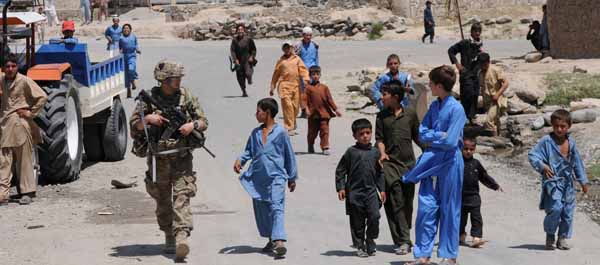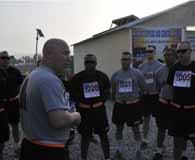Special Report from Afghanistan: The Battle for Kunar

 More than any place in eastern Afghanistan, Kunar province illustrates the difficulty of handing the fight over to Afghan national security forces while the war still rages. Across the province, a patchwork of U.S. and Afghan security forces are serving: Task Force Mountain Warrior (4th Brigade, 4th Infantry Division), security force assistance advisor teams (SFAATs) from Strike Brigade (2d Brigade, 101st Airborne Division), two battalions of 2d Brigade, 201st Afghan National Army (ANA) Corps, three battalions of the Afghan Border Patrol, and hundreds of Afghan uniformed police. They struggle to hold the cities and villages along the narrow Kunar River valley against the constant pressure of Afghan and Pakistani Taliban insurgents who flow back and forth across the porous border with Pakistan through countless mountain passes along Kunar’s eastern border. Accusations cross the border almost as frequently as insurgents – Pakistan accuses Afghan security forces of harboring Pakistani Taliban fighters while Afghanistan accuses the Pakistani military of firing rockets indiscriminately across the border at suspected Pakistani Taliban positions.
More than any place in eastern Afghanistan, Kunar province illustrates the difficulty of handing the fight over to Afghan national security forces while the war still rages. Across the province, a patchwork of U.S. and Afghan security forces are serving: Task Force Mountain Warrior (4th Brigade, 4th Infantry Division), security force assistance advisor teams (SFAATs) from Strike Brigade (2d Brigade, 101st Airborne Division), two battalions of 2d Brigade, 201st Afghan National Army (ANA) Corps, three battalions of the Afghan Border Patrol, and hundreds of Afghan uniformed police. They struggle to hold the cities and villages along the narrow Kunar River valley against the constant pressure of Afghan and Pakistani Taliban insurgents who flow back and forth across the porous border with Pakistan through countless mountain passes along Kunar’s eastern border. Accusations cross the border almost as frequently as insurgents – Pakistan accuses Afghan security forces of harboring Pakistani Taliban fighters while Afghanistan accuses the Pakistani military of firing rockets indiscriminately across the border at suspected Pakistani Taliban positions.
In the midst of this conflagration, U.S. forces are trying to build Afghan national security forces. SFAATs – hastily constructed from the best and brightest brigade and battalion commanders from 101st Airborne Division at Fort Campbell, Kentucky – have embedded in the provincial police headquarters, the ANA brigade headquarters, and key battalion headquarters all along the Kunar River valley. They are hard at work every day, building Afghan capacity to employ its enablers (artillery, mortars, route-clearing engineers, and logistics). But, more importantly, advisers are preparing the Afghans for the day when U.S. forces depart Kunar province and the Afghans must fight alone.
{default} Taliban insurgents are desperate to unhinge Afghan security forces before they are ready to assume the fight. Perhaps concerned by the recent dramatic increase in Afghan capability, insurgents launched a province-wide offensive on August 2, weeks ahead of the normal start date for late-summer offensives after the holy month of Ramadan. The initial onslaught, against police district centers in Marawara, Dangam, and Chapah Darah districts, was beaten back almost entirely by the Afghans themselves. In the process, the Afghans dealt the Taliban a severe setback and dozens of insurgent casualties. But, on August 7, the insurgents struck back. A motorcycle-borne suicide bomber found a lucrative target of opportunity near the provincial capital of Asadabad – a foot patrol leaving Combat Outpost Fiaz with the Task Force Mountain Warrior and Strike Brigade commanders. The Mountain Warrior commander was unhurt, but his senior enlisted adviser, Command Sergeant Major (CSM) Kevin Griffin, was killed while charging the attacker to protect his commander. A U.S. Army and U.S. Air Force officer and a USAID civilian were also killed.
Taliban insurgents are desperate to unhinge Afghan security forces before they are ready to assume the fight. Perhaps concerned by the recent dramatic increase in Afghan capability, insurgents launched a province-wide offensive on August 2, weeks ahead of the normal start date for late-summer offensives after the holy month of Ramadan. The initial onslaught, against police district centers in Marawara, Dangam, and Chapah Darah districts, was beaten back almost entirely by the Afghans themselves. In the process, the Afghans dealt the Taliban a severe setback and dozens of insurgent casualties. But, on August 7, the insurgents struck back. A motorcycle-borne suicide bomber found a lucrative target of opportunity near the provincial capital of Asadabad – a foot patrol leaving Combat Outpost Fiaz with the Task Force Mountain Warrior and Strike Brigade commanders. The Mountain Warrior commander was unhurt, but his senior enlisted adviser, Command Sergeant Major (CSM) Kevin Griffin, was killed while charging the attacker to protect his commander. A U.S. Army and U.S. Air Force officer and a USAID civilian were also killed.
Still, the Mountain Warriors and the Strike Brigade refuse to quit. They have picked themselves back up, dusted themselves off, and are once again hard at work, preparing Afghan national security forces to fight and win the battle for Kunar.
Lt.Col. Pat Proctor is currently deployed to eastern Afghanistan, serving as the chief of plans for the 1st Infantry Division. He is a veteran of both the Iraq and Afghan wars and the author of “Task Force Patriot and the End of Combat Operations in Iraq.” He is also a doctoral candidate in history at Kansas State University.
Click here to see all the articles that have been published in this series of reports from Afghanistan.
The views expressed in this article are those of the author and do not reflect the official policy or position of the Department of Defense or the US Government.


Kunar is no joke. I spent most of my tour in 2006 there as an ETT with 1st BDE 201st Corps. This new way the Army is training the ANA is garbage though………..we didn’t have these probloems when we had embed advisors instead.
As CMS Griffins sister, I appreciate the info. first I’ve seen in writing that my bro. charged. never heard it from anyone but Col. Mingus’s father
Sheila,
Your brother was a true hero, in the most profound sense of the word. This nation owes you and your family a debt it can never repay.